Recent Articles
Popular Makes
Body Types
2018 Ford Expedition Road Test and Review

2018 Ford Expedition exterior hero by Ron Sessions ・ Photo by Ron Sessions
Ford has completely redone its full-size SUV, the Expedition, for 2018. It still offers a smooth-riding independent rear suspension, power fold-flat third-row seats and a 3.5-liter EcoBoost twin-turbo V6 engine. But like the F-150 pickup, the redesigned model debuts an all-new weight-saving aluminum body. The 2018's freshly chiseled sheetmetal fits right in among Ford's other SUV offerings.
The 2018 Expedition is available in standard-length and long-wheelbase versions, with the larger of the two appropriately dubbed the MAX. Available trims for consumers are the base XLT at $51,695, midlevel Limited at $62,585 and top-of-the-line Platinum at $72,710, which range from being $4,570 to $8,540 more expensive than the 2017 models they replace. The extended-wheelbase MAX is a $2,600 upcharge and four-wheel drive adds around $3,000, depending on trim level. There is also a fleet-only XL model for police and first-responder duty.
Room to Roam
As with other full-size SUVs, it’s a hike to climb up into the Expedition’s cabin. Available running boards, power-retractable on Limited and Platinum trims, present themselves the moment you open the door, then fold away once the door is closed.
Once you're ensconced inside, there’s plenty of stretch-out space and room to stash odds and ends. The center console bin is sufficiently commodious to swallow a basketball. The front seats are comfortable, as you’d expect, and reasonably supportive. Standard fare on the new Expedition includes thoughtful touches such as power-adjustable foot pedals, dual gloveboxes, and push-button start. There is also an available panoramic vista roof, standard on the Platinum.
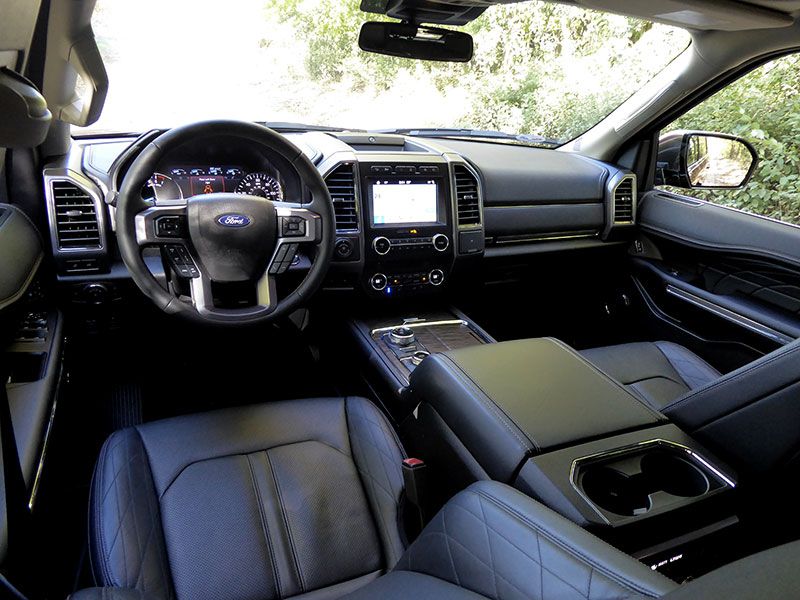
Photo by Ron Sessions
Infotainment to Go
The decent-sized 8-inch SYNC 3 center touchscreen display on Limited and Platinum trims is bolstered with voice commands and with analog knobs for volume and tuning, plus a bank of easy shortcut buttons. Bluetooth connectivity and SiriusXM satellite radio are standard on all models and every row gets two USB charging ports.
Tech advances on Limited and Platinum models include onboard 4G LTE WiFi for up to 10 devices and wireless device charging. Apple CarPlay and Android Auto compatibility are also part of the program.
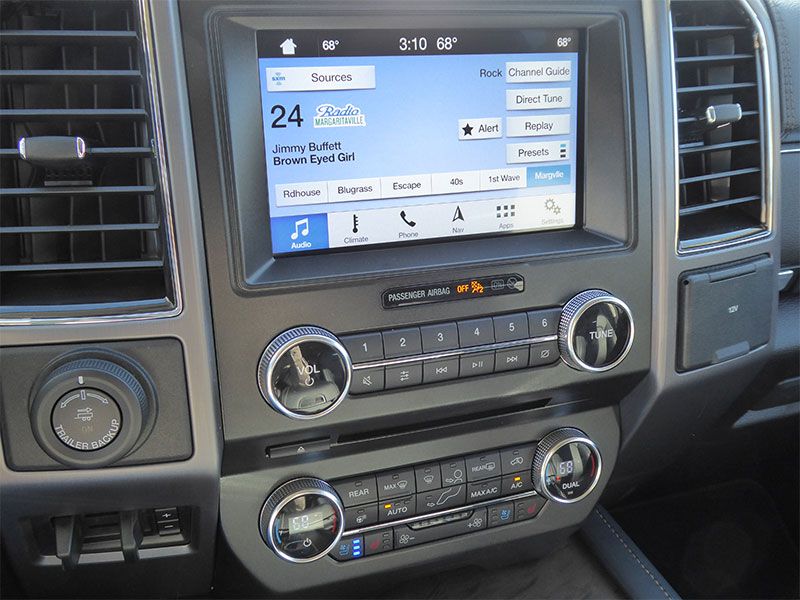
Photo by Ron Sessions
Safety First
Every 2018 Expedition comes standard with a backup camera, trailer-sway control and rear parking sensors. Limited models bring blind-spot and rear cross-traffic monitoring, and Platinum adds lane-keeping, a 360-degree camera, adaptive cruise control with stop and go, forward-collision mitigation with pedestrian detection, rain-sensing wipers and automatic high beams.
Ford’s enhanced active park assist helps make parallel parking something as big as the Expedition much easier. After initiating the system, drive by a parking spot to gauge if the SUV will fit, then stop, engage Reverse, gently accelerate and, once a chime tells you you're in the space, apply the brakes. The system does all the steering for you.
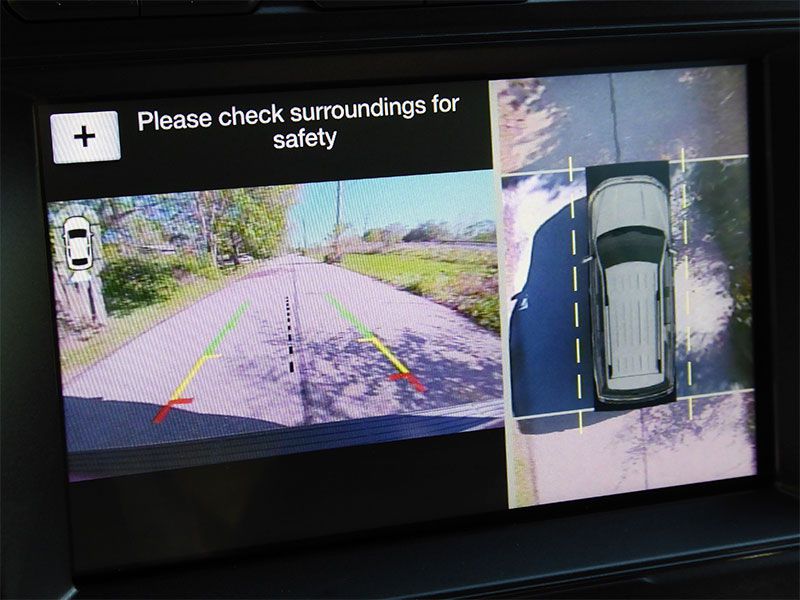
Photo by Ron Sessions
Tilt and Slide
One of the major reasons you want an SUV this big is for plenty of passenger space in the second- and third-row seats. The new Expedition obliges with a second-row seat that slides fore and aft almost 5 inches to accommodate longer or shorter legs. It also has a slide-and-tilt feature that eases access to the third row, even with a child safety seat installed. Available power-folding second- and third-row seatbacks ease the transformation from passenger- to cargo-hauling duties.
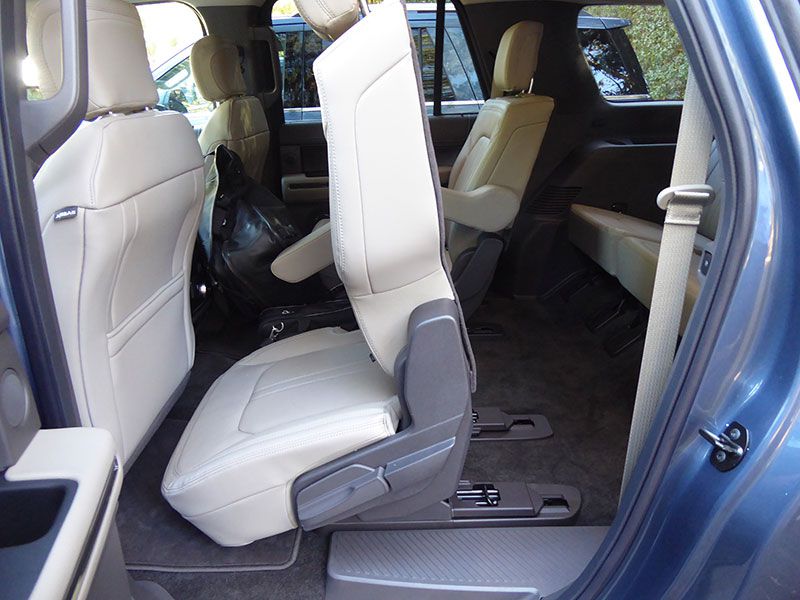
Photo by Ron Sessions
Open Wide
Relative to the sales-leading Chevrolet Tahoe, the standard-wheelbase Expedition is half a foot longer, has 6.5 inches more wheelbase, and offers almost 10 cubic feet of added cargo space with second- and third-row seats folded plus 16 inches of additional third-row legroom. Chalk up that third-row legroom advantage to the longer wheelbase, the sliding second-row seat design and the space-saving independent rear suspension.
The new extended-wheelbase MAX is 2.5 inches shorter than the competing Chevrolet Suburban, but the Ford offers equivalent cargo space and thanks to the sliding second-row seat, more than 6 inches greater third-row legroom. With all three rows folded flat, the 2018 Expedition can tote 104.6 cubic feet of cargo; the MAX version, up to 121.4 cubic feet.
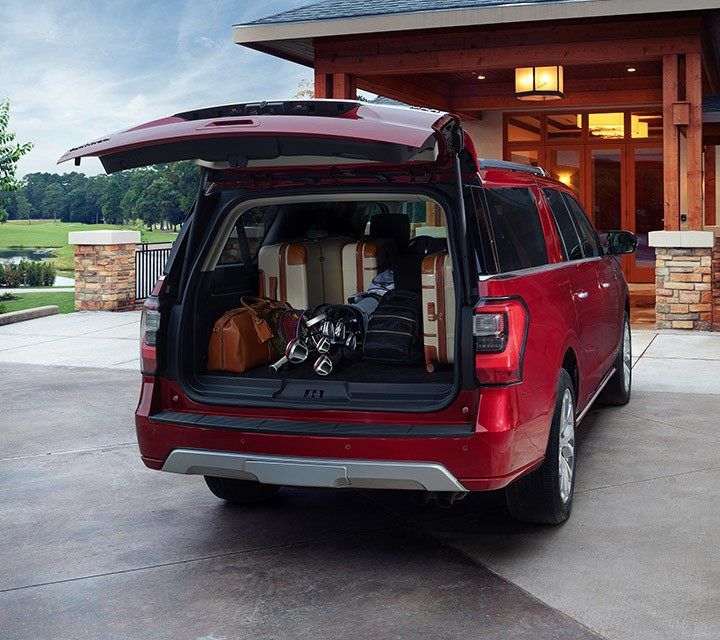
Photo by Ford
Cargo Management
New for 2018 is an available cargo manager with a removable cargo floor panel that can be reconfigured as a shelf or divider to keep items from moving around. All Expeditions have separate-opening liftgate glass, handy for dropping items in the back without opening the whole liftgate in tight spaces. Platinum models offer a hands-free liftgate that opens with a foot wave under the bumper.
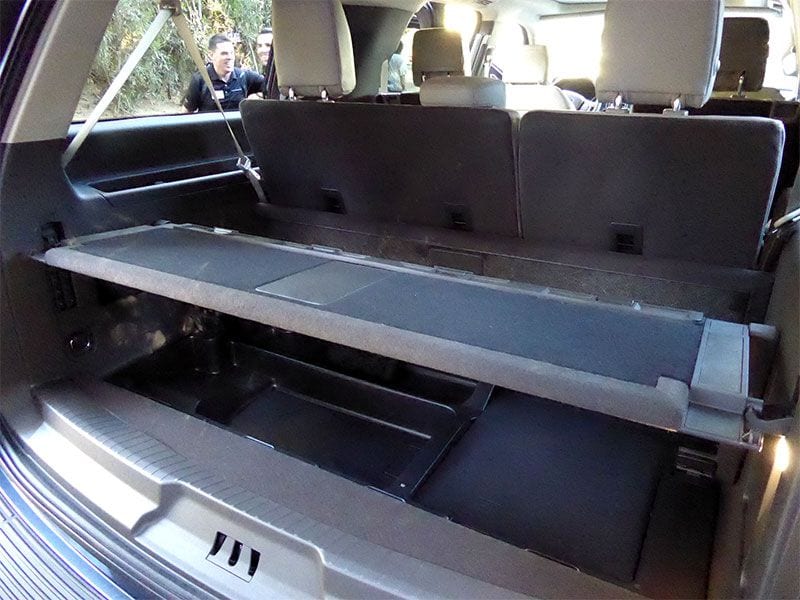
Photo by Ron Sessions
All Geared Up
Ford 2018, the Expedition's V6 engine is rated for 375 horsepower on most trims and 400 horsepower on the top-of-the-line Platinum, up from 365 horsepower last year. Torque also gets a proportional increase from 2017’s 420 lb-ft to 470 on most models and 480 in the Platinum. Meanwhile, a new 10-speed automatic transmission replaces last year's six-speed unit. Jointly developed with General Motors, the new gearbox adds a super low first gear for quick launches and a few extra tall overdrive ratios for extra-relaxed highway cruising. A rotary shift dial on the center console replaces the traditional PRNDL shift lever.
With the new transmission and lighter-weight aluminum body, the 2018 Expedition’s two-wheel drive base model’s EPA fuel-economy estimates see a 2 to 3 mpg improvement over the 2017 model, now hitting 17 mpg in the city and 24 mpg on the highway. A standard stop/start system shuts off the engine at stoplights then restarts it when the driver lifts a foot off the brake.
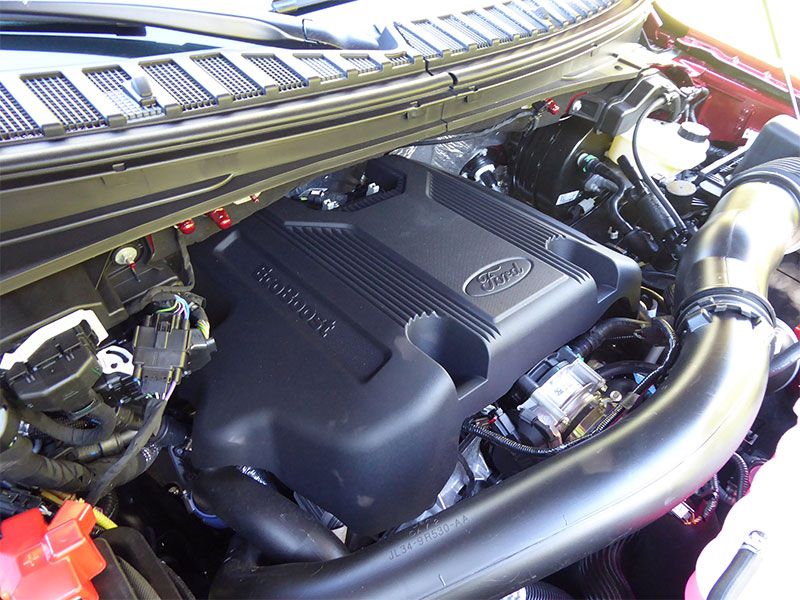
Photo by Ron Sessions
A la Modes
For 2018, the Expedition adds Ford’s Terrain Management System, which is controlled via a rotary dial on the console. Two-wheel drive versions offer Normal mode for everyday driving, Sport for improved response, Eco for fuel-saving and light cruising, Tow/Haul for trailering duty, and Snow/Wet for slippery roads.
Four-wheel drive models keep the Normal, Sport, Tow/Haul and Eco settings, but replace the Snow/Wet mode with specific applications dubbed Mud/Rut, Sand and Grass/Gravel/Snow modes. Each optimizes the throttle response, gear shifting, stability control and other systems for the driving situation at hand.
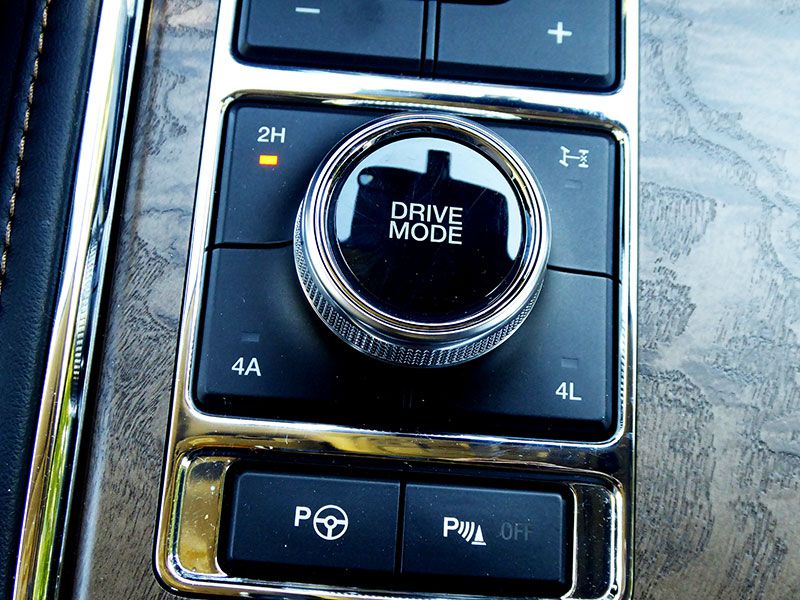
Photo by Ron Sessions
Leave the Dramamine at Home
The Expedition’s twin-turbo V6 is velvety at idle, with a turbine-smooth launch feel as boost builds quickly and seamlessly. You can merge into fast-moving traffic and get the nearly three tons up to speed without breaking a sweat. The 10-speed transmission’s shifts are barely detectable, the extra-wide range of ratios working with the turbo V6’s generous low- and mid-range torque to deliver satisfying thrust from gentle stop-and-go traffic around town to spirited full-throttle backroad passing maneuvers.
On the highway, the new Expedition’s ride motions are well damped, both with the standard steel springs or optional load-leveling air suspension. Body roll is minimal when rounding corners, and steering effort is neither too light nor too heavy, offering good precision. The SUVs large, flat sides can be affected by strong crosswinds, but overall the Expedition’s handling feels stable, secure and planted on the highway. The Expedition’s massive four-wheel disc brakes deliver reassuring stopping power from speed, though initial braking response could be crisper. Lastly, the same independent rear suspension that delivers such well-controlled body motions on the highway also does a surprisingly good job of traversing uneven off-road terrain.
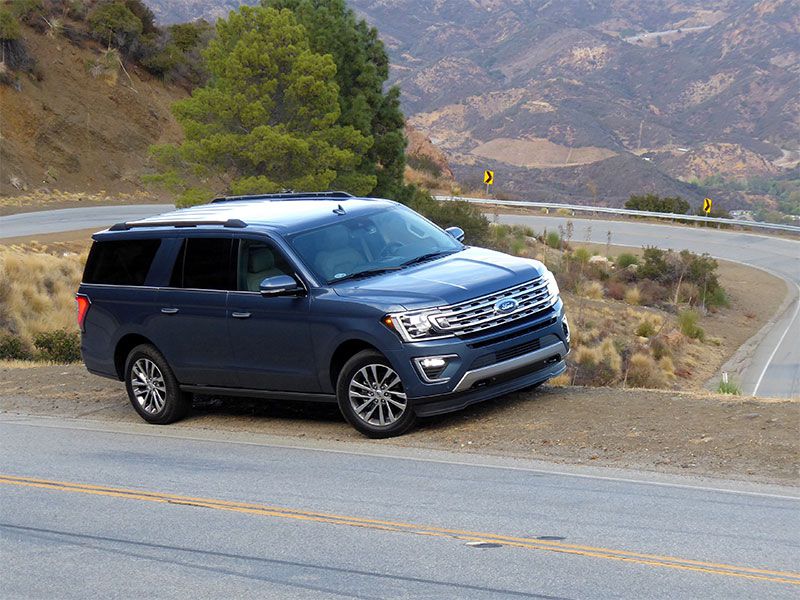
Photo by Ron Sessions
Bringing the Toys
A major consideration with full-size SUVs is trailer-towing ability. That figure is 9,300 pounds for a regular-wheelbase 2WD Expedition with the available heavy-duty trailer towing package. The extended-wheelbase MAX and four-wheel drive models are rated at a few hundred pounds less.
A new feature called Pro Trailer Backup Assist is a great tool, especially for drivers who only tow occasionally. The backup assist is a silver-dollar-sized knob on the dash you use to “steer” the Expedition and trailer when backing up instead of using the steering wheel. It takes a little practice, but once you get a feel for it, you’ll wonder how you ever backed up a trailer without it.
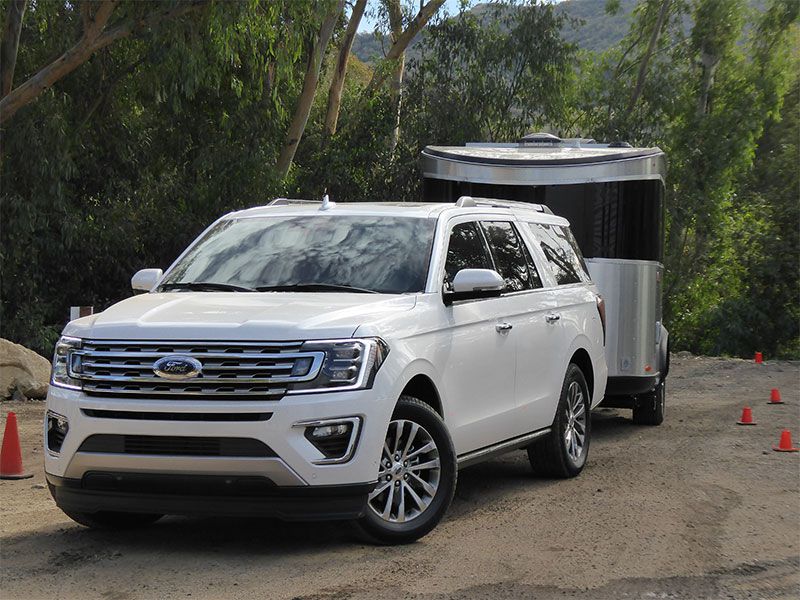
Photo by Ron Sessions